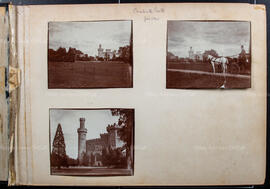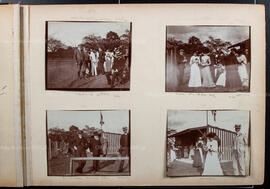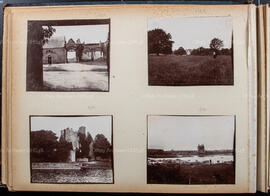Identity area
Reference code
Title
Date(s)
- 1870-1920 (Creation)
Level of description
Extent and medium
13 bound volumes, c. 1500 photographs
Context area
Name of creator
Biographical history
Middleton Westenra Biddulph was born on 17 August 1849 at Rathrobin, Mountbolus, King’s County (Offaly). He was one of six children, and the eldest surviving son of Francis Marsh Biddulph (1802–1868) and Lucy Bickerstaff (d. 1896). She was born in Preston, Lancashire and they married in 1845. The Bickerstaff connection was to be an important one for the surviving sons of Francis Marsh Biddulph, and led to a substantial inheritance in the 1890s for Middleton W Biddulph, and his brother Assheton, who lived at Moneyguyneen, Kinnitty.
The Biddulph ancestors were from Staffordshire, and later Wexford, and had arrived in King’s County from as early as 1694 or 1660. Lt Col. Biddulph held about 1,000 acres, of which perhaps 600 to 700 acres he farmed with the balance leased to his long-standing Protestant tenants. His landholding was principally in the townlands of Rathrobin and those adjoining of Clonseer, Cormeen, Kilmore and Mullaghcrohy, all near Mountbolus, in the civil parish of Killoughy and the barony of Ballyboy.
Middleton Biddulph went to Foxcroft House boarding school in Portarlington, aged 11, thereafter to the Royal School in Banagher, and joined the army when he was eighteen, enlisting with the Northumberland Fusiliers (Fifth Regiment). Initially an ensign or cornet, he rose in the ranks quickly and was a Lieutenant by 1871, Captain in 1881 and Major from 1885. Before retirement in 1896 he held the rank of Lieutenant Colonel. He spoke French, German and Hindustani and stations included: Hythe March (1872), St Helier’s, Chatham (1879) Portsmouth (1881), Agra (1880), Mullingar (1882), Newcastle (1886), Colchester (1887) and Aldershot (1891). It was while he was at Mullingar with the Ist Batt. Northumberland Fusiliers that he was appointed adjutant of the Ist Northumberland and ordered to proceed to Alnwick. It appears that he met his future wife, Vera Flower, following on from an introduction by her brother Stanley Smyth Flower (1871–1946), who was also an officer in the Royal Northumberland Fusiliers. They married in 1891. Vera Josephine Flower was a daughter of Sir William Flower, Director of the British Museum of Natural History, South Kensington, London. They did not have children.
When Biddulph retired from the army in the mid-1890s, he returned to Rathrobin and rebuilt the old house with the benefit of the Bickerstaff inheritance over the period 1898 to 1900. He employed Sir Thomas Drew as architect and William Beckett of Dublin as the builder. Once the new Rathrobin House was completed, Lt Col. Middleton Biddulph got on with his duties as a landlord and was a regular attender at the Petty Sessions, the Board of Guardians, and the County Infirmary, served as High Sheriff in 1901, and was appointed Deputy Lieutenant of the County in 1910. He was also on the board of the King’s County Joint Committee for Technical Instruction and the King’s County Farming Society. He and his wife left for England in June 1921 as the military campaign of the IRA in the locality intensified, and Rathrobin House was destroyed by Republican IRA forces in April 1923. While he seemed to have planned to return to Ireland after this, an attack on his land agent, Violet Magan, and his own declining health delayed plans to do so, and he died in Chelsea in May 1926.
Repository
Archival history
Content and structure area
Scope and content
13 volumes of photograph albums, known to Offaly Historical and Archaeological Society as the Magan-Biddulph Collection. complied by Lt. Col. Middleton Westenra Biddulph, landowner of the Rathrobin estate, near Mountbolus, County Offaly. Biddulph was born in Rathrobin in 1849, the eldest surviving son of Francis Marsh Biddulph and Lucy Bickerstaff. The Biddulph family's landholding was principally in the townlands of Rathrobin and those adjoining of Clonseer, Cormeen, Kilmore and Mullaghcrohy, all near Mountbolus, in the civil parish of Killoughy and the barony of Ballyboy. Middleton Biddulph enlisted with the Northumberland Fusiliers (Fifth Regiment) in 1867, rising to the ranks of Lieutenant Colonel before his retirement in 1896. Following his retirement, Biddulph and his wife, Vera Josephine Flower, returned to Rathrobin and rebuilt the old house over the period 1898 to 1900. Biddulph served as High Sheriff for King's County in 1901, and was appointed Deputy Lieutenant of the county in 1910.
As a keen amateur photographer, Biddulph used a quarter plate camera to document his various areas of interest including; his military career with the Northumberland Fusiliers; visits to country houses across Ireland, England and Scotland; members of the Biddulph and Magan family; visits around Ireland as part of the Royal Society of Antiquarians; interior and exterior photographs of Rathrobin House; agricultural work on the estate. There is also an extent of photographs of tenant families and employees of the Rathrobin estate, featured across the photograph albums.
Biddulph and his wife left for England in June 1921 as the military campaign of the IRA in the locality intensified, and Rathrobin House was destroyed by Republican IRA forces in April 1923. While he seemed to have planned to return to Ireland after this, an attack on his land agent and niece, Violet Magan, and his own declining health delayed plans to do so, and he died in Chelsea in May 1926. The albums were presented to Offaly Historical and Archaeological Society in 1997 by Brigadier William Magan, a nephew of the photographer.
Appraisal, destruction and scheduling
Accruals
System of arrangement
The photographs were evidently developed and curated in an album by Biddulph at a later date from when they were created. While the prints have been placed in the albums in a rough chronological order, there are several instances where the dates are out of sequence. In the original order of the albums, albums 1-8 run in chronological order, while albums 9-13 are arranged loosely around a subject or event. In the finding aid, each page is described separately, and transcripts of the captions under each photograph appear in quotation marks. Untitled photographs are listed as such, or if an approximation of its content is made by the archivist, the description will appear in square brackets. Each photograph has been numbered sequentially.
An original catalogue was prepared by Offaly Historical and Archaeological Society in 1998 when the photographs were first acquired by the Society.
Conditions of access and use area
Conditions governing access
Original albums available to view by appointment only. Please email [email protected] for more information.
Conditions governing reproduction
Reproduction permitted for research and private study only as per the Copyright and Related Rights Act (2000). No reproduction in print, online, or broadcast, without prior permission. High resolution images available by request.
Language of material
Script of material
Language and script notes
The captions in the album have been transcribed as they appear, and are placed in quotation marks.
Physical characteristics and technical requirements
Finding aids
Allied materials area
Existence and location of originals
Existence and location of copies
2001/077 Magan Collection, Irish Architectural Archive.
Related units of description
Publication note
'The Story of an Irish Family' by William Magan (Salisbury, 1983)
'An Irish Boyhood' by William Magan (Durham, 1996)
'Rathrobin and the two Irelands: the photographs of Middleton Biddulph 1900–1920' by Michael Byrne (Esker Press, Tullamore 2021).
Notes area
Alternative identifier(s)
Access points
Subject access points
Place access points
Name access points
- Biddulph, Middleton Westenra, Lt Col (Subject)
Genre access points
Description control area
Description identifier
Institution identifier
Rules and/or conventions used
Dates of creation revision deletion
November 2024, Orla Connaughton











